Quando começamos a blogar com usuários do WordPress, o Editor Clássico era tudo o que tínhamos. Agora, mesmo com o Gutenberg sendo o padrão, algumas pessoas preferem o Editor Clássico para uma experiência de escrita direta.
Embora o Gutenberg seja poderoso, ele nem sempre é o mais adequado para as necessidades de todos. Se você estiver administrando um site comercial ou gerenciando vários sites de clientes, às vezes o Editor Clássico familiar é exatamente o que você precisa.
Vamos mostrar a você as maneiras mais confiáveis de desativar o Gutenberg e continuar usando o Editor Clássico.
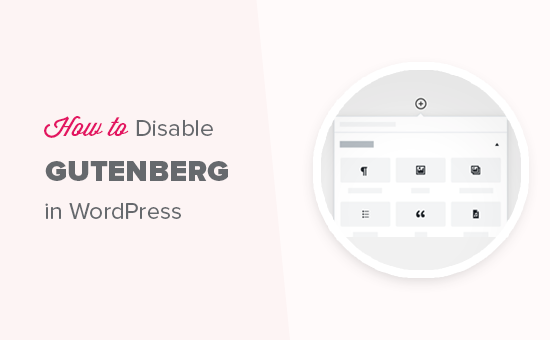
O que é o Gutenberg?
Gutenberg é o nome do editor de blocos do WordPress. Ele foi criado para tornar a escrita no WordPress mais moderna.
Ele tenta funcionar como um plug-in de construtor de páginas, pois permite arrastar e soltar itens em uma postagem ou página. O objetivo é oferecer mais flexibilidade e permitir que os usuários do WordPress criem layouts exclusivos para seu conteúdo com conteúdo multimídia avançado.
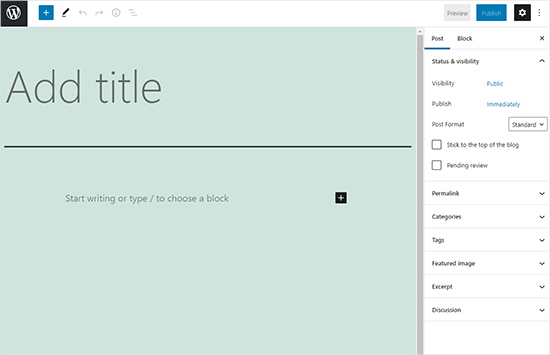
Desde o lançamento do WordPress 5.0, o editor de blocos tem sido o editor padrão do WordPress.
Por que desativar o Editor Gutenberg no WordPress?
Muitos proprietários de sites que usam o WordPress há anos se sentem mais confortáveis com o editor clássico. Além disso, como o editor de blocos é relativamente novo, alguns plugins podem não ser totalmente compatíveis com ele.
Felizmente, há maneiras de usar o editor clássico, mesmo no WordPress 5.0 ou posterior.
Na seção a seguir, mostraremos como desativar facilmente o Gutenberg e continuar usando o editor clássico do WordPress.
Aqui está uma rápida visão geral de todos os métodos que compartilharemos neste guia:
Pronto? Vamos começar.
Método 1. Desativar o Gutenberg com o plug-in WPCode (recomendado)
No WPBeginner, recomendamos desativar o Gutenberg usando o plug-in WPCode, o melhor plug-in de snippets de código para WordPress.

Gostamos do fato de que ele facilita a adição de código personalizado no WordPress sem precisar editar o arquivo functions.php do seu tema. Portanto, não há motivo para se preocupar com a quebra de seu site WordPress. Para saber mais, consulte nossa análise do WPCode.
Esse plug-in também apresenta uma biblioteca de snippets de código integrada, facilitando a personalização das funções do WordPress.
Na biblioteca, você encontrará trechos de código verificados para solicitações de recursos populares, como desativação do Gutenberg, desativ ação da API REST do WordPress, desativação de atualizações automáticas e muito mais. Isso elimina a necessidade de instalar vários plug-ins de uso único.
Para começar, você precisa instalar e ativar o plug-in gratuito WPCode. Se precisar de ajuda, consulte nosso guia sobre como instalar um plug-in do WordPress para obter instruções passo a passo.
Observação: o WPCode tem um plano gratuito que você pode usar. No entanto, a atualização para a versão profissional lhe dará acesso a recursos como uma biblioteca em nuvem de trechos de código, lógica condicional inteligente, recurso de trecho de bloco e muito mais.
Depois que o plug-in for ativado, primeiro você precisará acessar Code Snippets “ Library no painel do WordPress.
Em seguida, você deverá procurar o snippet ‘Disable Gutenberg Editor (use Classic Editor)’ e clicar no botão ‘Use snippet’.
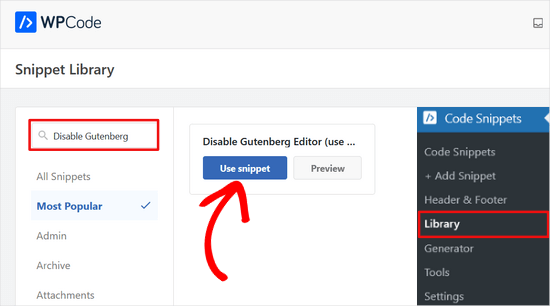
Na próxima tela, você verá que o WPCode adicionou automaticamente o código.
Ele também define o método de inserção adequado e adiciona um título e tags para ajudá-lo a lembrar para que serve o código.
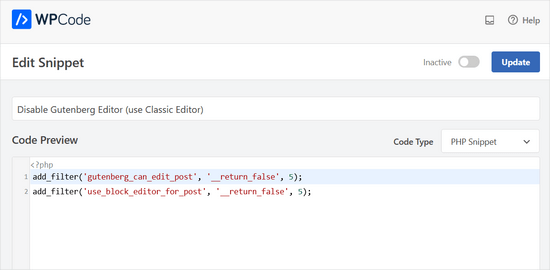
A partir daí, tudo o que você precisa fazer é alternar a chave de “Inativo” para “Ativo”.
Depois disso, clique no botão “Update” (Atualizar).
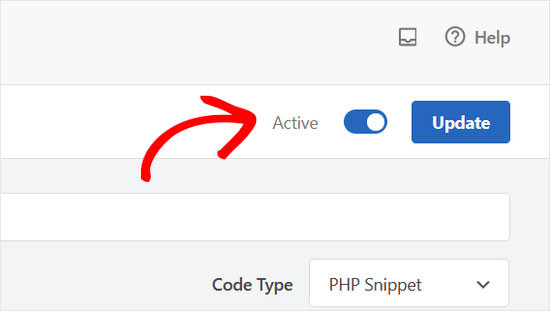
É isso aí. O editor de blocos do Gutenberg agora está desativado, e você pode usar o editor Clássico.
Método 2. Desativar o Gutenberg com o plug-in do Editor Clássico
Para esse método, usaremos o plug-in Classic Editor, que é desenvolvido e mantido pelos principais colaboradores do WordPress.
A primeira coisa que você precisa fazer é instalar e ativar o plug-in Classic Editor. Se precisar de ajuda, consulte nosso guia passo a passo sobre como instalar um plug-in do WordPress.
O plug-in funciona imediatamente e desabilitará o editor Gutenberg após a ativação.
Ele também permite que você mantenha o Gutenberg e o editor Classic ao mesmo tempo.
Você pode definir isso nas configurações do plug-in. Basta acessar Configurações ” Redação na área de administração do WordPress. Você verá a opção para fazer isso em “Configurações do editor clássico”.
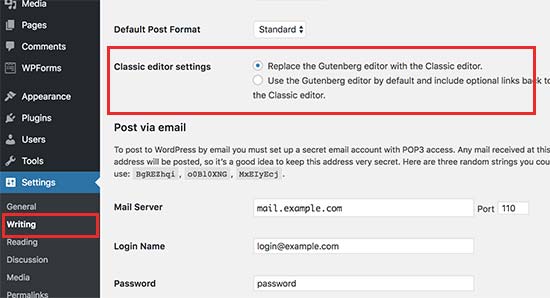
Não se esqueça de clicar no botão “Save Changes” (Salvar alterações) para armazenar suas configurações.
Agora você verá um novo link no menu Posts para criar novos posts usando o editor clássico.
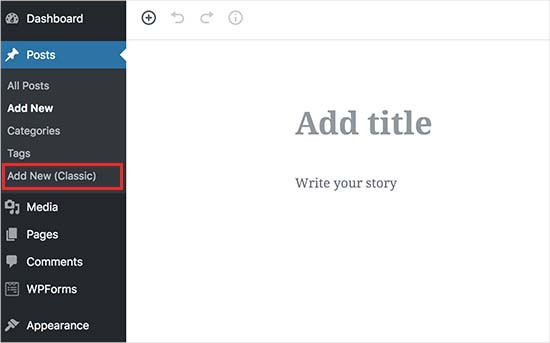
Você também poderá editar artigos antigos usando o editor clássico.
Basta acessar a página Postagens ” Todas as postagens e você verá um link “Editar (Clássico)” abaixo das postagens.
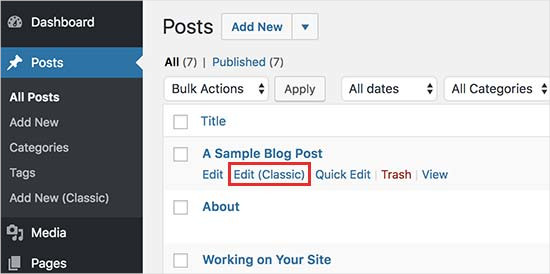
Método 3. Usar o Editor Clássico com o Plug-in Gutenberg desativado
Se você quiser desativar o Gutenberg para determinadas funções de usuário e tipos de postagem, esse método o ajudará a fazer isso.
Primeiro, você precisa instalar e ativar o plug-in Disable Gutenberg. Se precisar de ajuda, consulte nosso guia passo a passo sobre como instalar um plug-in do WordPress.
Após a ativação, você precisará visitar a página Settings ” Disable Gutenberg para definir as configurações do plug-in.
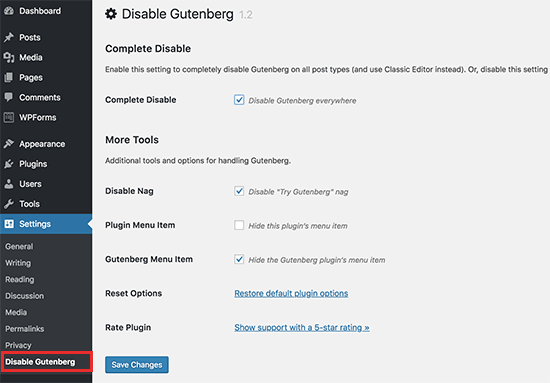
Por padrão, o plug-in desabilitará o Gutenberg em todos os lugares para todos os usuários do seu site. No entanto, se você quiser limitá-lo a determinadas funções de usuário e tipos de postagem, desmarque a opção “Desativação completa”.
Ao desmarcá-la, serão exibidas mais opções para desativar seletivamente o Gutenberg para determinadas funções de usuário, tipos de postagem, modelos de tema ou postagens individuais.
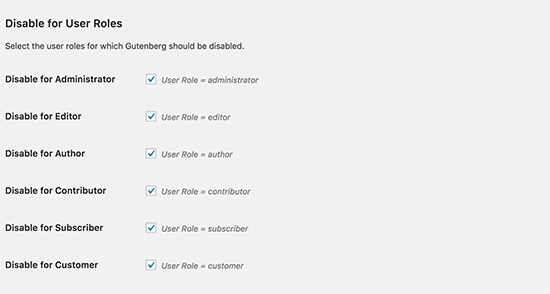
Essa opção é útil se você estiver usando um plug-in do WordPress que não seja compatível com o Gutenberg, mas quiser usar o Gutenberg em outras áreas do seu site.
O WordPress é o criador de sites mais popular do mundo, alimentando mais de 43% de todos os sites da Internet. Ele tem milhares de plug-ins e temas e alimenta todos os tipos de sites, desde lojas de comércio eletrônico até comunidades de membros.
Muitos desses plug-ins agora são compatíveis com o editor de blocos. Por exemplo, o WPForms inclui um bloco de formulário de contato personalizado que permite inserir facilmente seus formulários em qualquer post ou página com o editor de blocos.
No entanto, muitas ferramentas de terceiros ainda dependem muito do editor clássico do WordPress e podem não ser totalmente compatíveis com o editor de blocos.
Se esse for o caso, essas configurações podem ser muito úteis para você.
Não se esqueça de clicar no botão “Save Changes” (Salvar alterações) para armazenar suas configurações.
Esperamos que este artigo tenha ajudado você a desativar o Gutenberg e manter o editor clássico no WordPress. Talvez você também queira ver nossa lista de perguntas comuns sobre o Gutenberg respondidas ou nosso guia sobre como desativar o Fullscreen Editor no WordPress.
Se você gostou deste artigo, inscreva-se em nosso canal do YouTube para receber tutoriais em vídeo sobre o WordPress. Você também pode nos encontrar no Twitter e no Facebook.





Moinuddin Waheed
classic editor has been great for writing content and specially for bloggers where the main aim is to publish regular content.
moreover, making table is a lot of easier when it comes to classic editor whereas Gutenberg editor still lags flexibility in table customisations.
I had to use classic editor mainly for making table.
Is there a way we can have both the editors and can make a switch to utilise the best features of both the editors?
or will we need to disable one to use the other?
WPBeginner Support
You would need to only use one editor at a time as swapping editors can cause formatting issues.
Admin
mohadese esmaeeli
One of the issues with Gutenberg that has bothered me is the absence of the ‘Show Revisions’ feature, which is available in the classic editor. Another problem is that Ctrl+Z doesn’t work in this editor, and I’m always afraid that my writing might be lost due to an internet interruption, WordPress hang-ups, or any other reasons.
Ahmed Omar
As a new beginner on wordpress, I found that classic editor is easy for me to use.
Should I continue using it or I should train myself to use block editor from now
WPBeginner Support
If possible it would be good to start learning the block editor as WordPress updates there will be more and more added to the block editor.
Admin
Tikyda
Thanks a lot. I did not know it could be so quick to get rid of the new wordpress text editor. I used the plugin you recommended.
WPBeginner Support
Glad our guide was helpful!
Admin
VickyR
WOW! Did this article “find me” at the right time! I think this is the best WordPress site on the internet, have been following it a long time and decided put foot in the waters and test a new site with WordPress 6.0.1 (local install). The toggle button popping up and hiding all the dashboard options was driving me crazy every time I tried to create a new page or post! Have been sitting here all day trying to figure out stop the Dashboard menu from dissappearing. Didn’t realize it was Gutenberg vs Classic Editor. THANK YOU SO MUCH FOR THIS POST wpbeginner!


WPBeginner Support
Glad to hear our article was helpful!
Admin
Theresa Southern
Seems to be working like a charm! Thanks for the tip!
WPBeginner Support
Glad to hear it is working for you!
Admin
Frances Sinclair
Unfortunately I can’t install the plugin as it requires me to have a Business Plan. I know I had plugins on my blogs but can’t install any now. Have been forced into block editor.
WPBeginner Support
To clarify, our tutorials are for WordPress.org sites, you can see the difference between the two in our article below:
https://www.wpbeginner.com/beginners-guide/self-hosted-wordpress-org-vs-free-wordpress-com-infograph/
We also have a free transfer service should you be interested in moving your site from WordPress.com to WordPress.org.
Admin
Brigitte
Hi, I’ve downloaded the plug in for the classic Editor since I couldn’t figure out how to Indent paragraph in the Block editor. I’m now able to “indent” a paragraph in the Classic Editor. I then save the Classic editor and close it.
However, as soon as I open the Classic Editor, my “indents” are gone (Even though I had saved my post)? I’m used to the Block Editor, but it’s missing some functionalities (like indents). Not sure what to do? I prefer not to use the Classic Editor too much, only for the missing functionalities. Can we not use both?
WPBeginner Support
You would not want to swap between editors as that can cause different issues like the one you are running into. For those situations, you would want to use the Classic block for that styling or stay in the classic editor.
Admin
John
Hi,
installing the classic editor was easy on WP 5.6
Only thing is that the classic “look” is not there ? It has a different interface ?
WPBeginner Support
You would want to ensure you’ve enabled the classic editor in the plugin’s settings for it to be visible.
Admin
Angelina
I’m using wordpress.org, but when I go to the writing settings this option isn’t there..? I’m not sure what I’m doing wrong
WPBeginner Support
You would want to ensure the plugin is installed and activated for the option to be available.
Admin
Frank White
I’m using WordPress COM. On Oct 1, 2020 when I added a post to my blog I was shocked to discover that the familiar Classic interface had been replaced by Gutenberg without my permission.
Even worse, when I tried to restore the Classic interface I got this message — “To install plugins you need to upgrade to a business plan.”
WPBeginner Support
You would need to reach out to WordPress.com’s support for what the current options that they have available are without upgrading to be able to use plugins. Our guides are for WordPress.org sites currently.
Admin
Matt
On free plans, you can’t install the plugin, but it’s still possible to use the old editor. Go to the WP Admin page which is located at blogname.wordpress.com/wp-admin. Click Posts->All Posts to get a list of your posts. If you hover over a post title, you can choose Classic Editor below it. Note: This may not work if your WP account is new.
Pam
Thank you for this plugin. I’ll want to create blog posts again, thanks to this plugin!
WPBeginner Support
Glad our recommendation was helpful
Admin
Hendrik
Hi,
I recently updated my site to WP 5.5.1 – no choice, but Gutenberg. When I install the Classic Editor plugin, the article previews get a 404 error. Any ideas, whether it’s the theme or other plugins interferring?
WPBeginner Support
It would depend on what you have on your site, you would want to follow the steps in our article below for how to troubleshoot an error like this:
https://www.wpbeginner.com/beginners-guide/beginners-guide-to-troubleshooting-wordpress-errors-step-by-step/
Admin
Mark
I happened to do a fresh WP installation last night and noticed that block editing is the default status as now the block editor is built into the WP core. A couple years ago I installed the Gutenberg plugin. Is it possible to uninstall the plugin and retain the block editor or will uninstalling the Gutenberg plugin disable block editing? It would be a disaster to uninstall it and find pages and posts created with the Gutenberg plugin all in a mess.
WPBeginner Support
If your site is up to date you should be able to uninstall the Gutenberg plugin safely.
Admin
Heather Davis
Hi. I have been using the Classic Editor plugin, but isn’t there an expiration to that? I thought I remember they will require everyone to move over to Gutenburg by a certain date. Do you know about this?
I ask because I was going to hire someone to recreate my blog in Gutenburg blocks… because I thought I had to eventually. But I don’t want to do the dust has settled on Gutenburg and all the kinks are worked out.
Advice?
WPBeginner Support
They mention this on the Classic editor plugin page itself. Currently, the plugin will be supported until 2022, or as long as necessary.
Admin
Michael
The new block editor sucks.
WPBeginner Support
Some people think that which is why the Classic Editor plugin is available, should you not want to use the block editor you can use that plugin. We would recommend trying the block editor when you can as it has improved over time.
Admin
ali
tnq for sharing this amazing information, that’s work wonderful for me
WPBeginner Support
You’re welcome, glad our guide was helpful
Admin
Bapan Mistri
Thanks a lot for the information.
WPBeginner Support
You’re welcome
Admin
Dharmesh Patel
Great post. It helped me a lot.
WPBeginner Support
Thank you, glad our tutorial was helpful
Admin
ValerieB
I’ve read the post above and do not see these options when I look at settings on my 2nd site. When I choose plug-ins, I get the message that I have to upgrade to a paid plan in order to be able to use either the disable gutenberg plugin or the classic editor plugin.
Is this correct? People with free sites are not allowed to disable the “new block editor”? Thank you.
WPBeginner Support
Our tutorials are for WordPress.org sites, not WordPress.com sites. WordPress.com should be able to let you know the options available but they may have an option in the top right of the post editor unless it has been removed
Admin
Cheryl
In trying to find a way out of Gutenberg I installed Classic Editor, also Classic Editor add-on, and then finally Disable Gutenberg. A third party tool I used to use used to work perfectly for months. Now it does not, even with this plugins. Do I have too many plugins at this point? Suggestions? Thank you.
WPBeginner Support
You would only want one plugin for the classic editor active, you may be running into a conflict between the plugins that is preventing the classic editor from displaying.
Admin